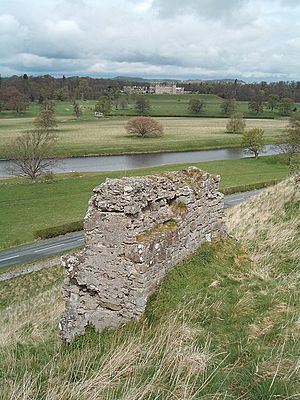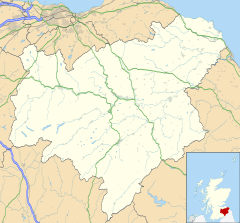Roxburgh facts for kids
Quick facts for kids Roxburgh
|
|
|---|---|
 Roxburgh Castle, River Tweed and Floors Castle |
|
| Population | 419 (2001) |
| OS grid reference | NT713337 |
| Civil parish |
|
| Council area | |
| Lieutenancy area |
|
| Country | Scotland |
| Sovereign state | United Kingdom |
| Post town | KELSO |
| Postcode district | TD5 |
| Dialling code | 01573 |
| Police | Lothian and Borders |
| Fire | Lothian and Borders |
| Ambulance | Scottish |
| EU Parliament | Scotland |
| UK Parliament |
|
| Scottish Parliament | |
Roxburgh (/ˈrɒksbərə/) is a historic area in the Scottish Borders, Scotland. It used to be a very important town, known as a royal burgh. A royal burgh was a special town that had rights given by the king or queen. Roxburgh was a major trading center in Scotland during the Middle Ages. For a while, it was almost like the capital city, especially when King David I lived there.
Contents
A Look Back: Roxburgh's History
Why Roxburgh Was Important
Roxburgh was important for a few reasons. It was located in a very good spot in Lowland Scotland. This area had lots of fertile land for farming. The town was also right on the River Tweed. This river allowed goods to be easily moved by boat to the main port of Berwick-upon-Tweed. Roxburgh's location also helped protect Scotland from invasions by English armies.
The Royal Burgh and Its Castle
The town of Roxburgh was built on a strong piece of land. It was surrounded by the River Tweed and the River Teviot. Roxburgh Castle stood at the narrowest part of this land, guarding the town. King David I made Roxburgh a royal burgh, giving it special status.
At its busiest time, between the reigns of William the Lion and James II, Roxburgh was home to the Royal Mint. This is where coins were made for the whole country. The town also had three churches and schools. These schools were run by the monks from Kelso Abbey. In 1237, Alexander III, who would later become king, was born in Roxburgh.
Battles and Destruction
During the Scottish Wars of Independence, English and Scottish forces fought many times over Roxburgh. They captured and recaptured the town over and over again. King Edward III of England even stayed at Roxburgh Castle during his time in Scotland. He spent at least two of his birthdays there.
The castle was attacked many times. A famous attack happened in 1314, just before the Battle of Bannockburn. In 1460, the Scots finally took the castle back. After this, both the town and the castle were destroyed. Roxburgh never became important again. This was partly because England took control of Berwick-upon-Tweed in 1482. Without a port nearby, Roxburgh lost its main reason for being a big trading town.
What Remains Today
Today, almost nothing is left of the old town of Roxburgh. You can still see some ruined parts of the castle walls. The site of the old town is south of modern Kelso and Floors Castle. These places are on the other side of the River Tweed. Jedburgh later became the main town for the area, taking Roxburgh's place.
For a long time, not much was known about the old Roxburgh site. This was because the landowner, the Duke of Roxburghe, did not allow archaeologists to dig there. However, in 2003, the TV show Time Team was allowed to do some digging. Their discoveries were shown on TV in 2004.
What's in a Name? Etymology
The name Roxburgh likely comes from an old English phrase. It probably means "rook's burgh," which refers to a "rook" (a type of bird) and a "burgh" (a fortified town).
Roxburgh Village Today
Today, the name Roxburgh belongs to a small village. This village is about 2 miles (3.2 km) south-southwest of where the historic town of Roxburgh used to be.
See also


